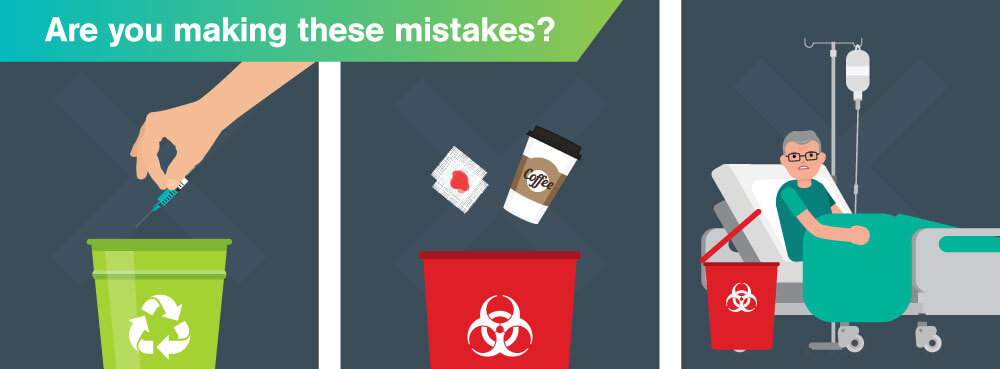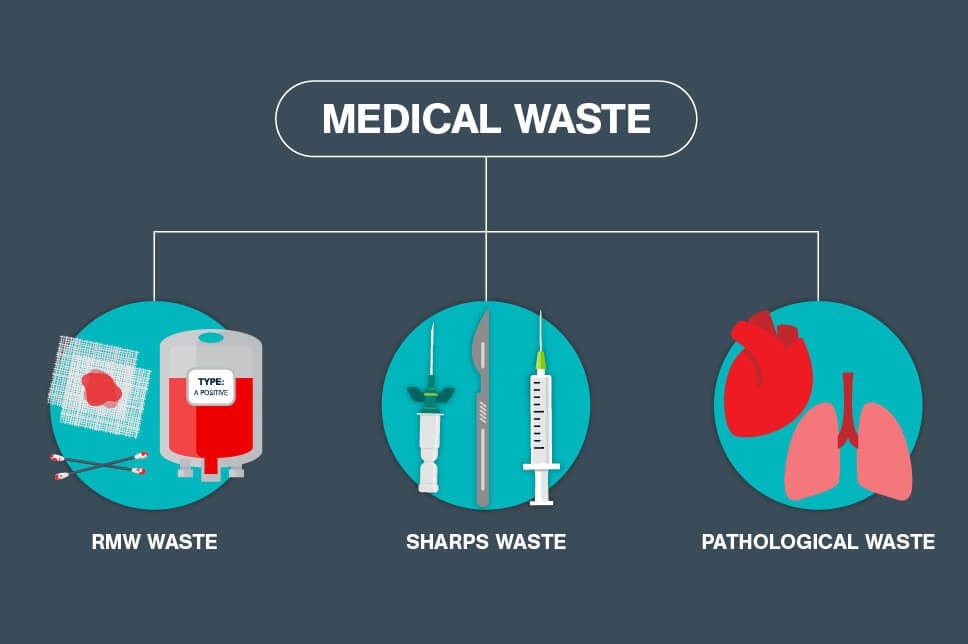Reliable and Liable Medical Waste Removal: Protecting Individuals and the World
Lasting Solutions for Medical Garbage Disposal
The proper management and disposal of medical waste is important in maintaining a secure and sustainable health care system. As the quantity of clinical waste remains to rise, locating sustainable services comes to be increasingly essential. This demands the fostering of efficient and eco-friendly methods for taking care of clinical waste. This introduction will discover different sustainable services for medical waste disposal, consisting of waste partition and sorting, on-site waste therapy systems, recycling and reuse programs, waste-to-energy conversion innovations, along with cooperation and education efforts. By executing these solutions, medical care centers can not only reduce the ecological influence of clinical waste, however also ensure the safety and security of health care employees and the public.
Waste Partition and Sorting
The process of waste partition and sorting is important in making sure proper administration and disposal of clinical waste. Medical waste is identified right into different groups based upon its prospective risk to human wellness and the environment. Appropriate partition and sorting of waste help to lessen the threat of contamination and guarantee that each sort of waste is handled and dealt with suitably.
The primary step in waste partition and sorting is to identify and divide various types of medical waste at the point of generation. This includes identifying the numerous groups of waste, such as infectious waste, sharps waste, pharmaceutical waste, and chemical waste. medical waste disposal. Each classification calls for details handling and disposal methods to stop harm to health care employees, individuals, and the setting

On-site Waste Therapy Equipments
Proceeding from the previous subtopic on waste segregation and sorting, an effective solution for lasting clinical waste disposal is the implementation of on-site waste treatment systems - medical waste disposal. These systems enable healthcare centers to treat their clinical waste on-site, lowering the demand for transport and disposal at off-site facilities. On-site waste treatment systems generally include innovations such as autoclaves, microwave systems, or chemical sanitation systems
Autoclaves, generally made use of in healthcare setups, utilize high-pressure vapor to sterilize and treat medical waste. This process effectively eliminates microorganisms, viruses, and other possibly hazardous microbes, making the waste secure for additional handling and disposal. Microwave systems, on the various other hand, usage microwave radiation to heat and deal with the waste, achieving comparable outcomes to autoclaves.
Chemical disinfection units include the use of chemicals to disinfect and treat clinical waste. These systems can use various disinfectants, such as chlorine-based options, to neutralize pathogens and minimize the risk of contamination. The cured waste can after that be safely gotten rid of in normal waste streams or go through more treatment, such as shredding or incineration.
Implementing on-site waste therapy systems provides several advantages. It lowers the environmental impact connected with transporting clinical waste to off-site centers, reducing carbon discharges and the danger of crashes throughout transportation. Additionally, it supplies medical care centers with even more control over the therapy process, guaranteeing conformity with policies and lowering the capacity for unauthorized access to delicate medical waste.
Recycling and Reuse Programs
To further enhance sustainable medical waste disposal techniques, healthcare centers can execute recycling and reuse programs, building on the foundation of on-site waste treatment systems. Recycling and reuse programs offer an additional layer of environmental responsibility by diverting clinical waste from garbage dump and searching for alternative usages for sure materials.
One secret aspect of recycling and reuse programs is the segregation of waste at the source. medical waste disposal. By executing proper waste partition protocols, medical care facilities can separate recyclable materials, such as plastics, steels, and glass, from non-recyclable waste. This permits the efficient recycling of these products, lowering the requirement for virgin resources and minimizing the environmental effect of clinical garbage disposal
In addition to recycling, healthcare facilities can check out chances for recycling particular clinical items. Single-use items like surgical drapes and dress can be sanitized and reused, reducing the requirement for new products and lessening waste generation. Multiple-use sharps containers can also be used, reducing the quantity of plastic waste generated from non reusable containers.
Applying recycling and reuse programs requires proper facilities and training - WasteX Medical Waste Disposal. Healthcare facilities should buy ideal reusing containers, segregation systems, and sterilization tools, along with make certain staff are enlightened on proper waste management methods
Waste-to-Energy Conversion Technologies
One prospective technique to attend to medical garbage disposal sustainably is via the utilization of waste-to-energy conversion modern technologies. These modern technologies supply a promising option to the expanding trouble of clinical waste, which postures significant ecological and public wellness dangers. Waste-to-energy conversion includes converting the natural components of medical waste into energy, such as warm or electrical energy, through numerous processes like incineration, gasification, and pyrolysis.
Incineration is the most commonly made use of waste-to-energy innovation for medical garbage disposal - WasteX Medical Waste Disposal. It entails the controlled burning of waste at heats, converting it right into ash, gases, and warm. This warmth can be made use of to create steam, which can then be transformed right into electrical power
Pyrolysis and gasification are newer modern technologies that use more ecologically pleasant alternatives to incineration. Pyrolysis includes warming the waste in the lack of oxygen, leading to the production of gases and char. Gasification, on the other hand, converts waste into an artificial gas or "syngas" that can be made use of as a gas for electricity generation or other commercial procedures.
These waste-to-energy conversion innovations not just lower the quantity of clinical waste but also offer a source of renewable resource. In addition, they can help in reducing greenhouse gas discharges and reliance on fossil gas (WasteX Medical Waste Disposal). It is crucial to make certain that these innovations are carried out with proper emissions regulate procedures to minimize any potential negative effects on air top quality and public health and wellness.
Partnership and Education Campaigns
Collaboration among stakeholders in the healthcare sector is crucial for applying lasting remedies for clinical waste disposal. In order to effectively address the obstacles related to medical waste monitoring, it is vital for healthcare centers, waste management firms, regulatory authorities, and other pertinent events to function with each other.

In addition, education and learning efforts play a crucial function in promoting sustainable practices. Healthcare professionals need to be familiar with the ecological influence of inappropriate waste monitoring and the value of carrying out sustainable services. Training programs and instructional products can assist them comprehend the proper segregation of waste, using environmentally friendly alternatives, and the benefits of waste-to-energy conversion modern technologies.
Cooperation and education and learning can also facilitate the growth of laws and guidelines for medical garbage disposal. By collaborating, stakeholders can add to the development of extensive policies that make sure risk-free handling, transport, and therapy of medical waste.
Conclusion
Finally, embracing sustainable services for clinical waste disposal is crucial in order to reduce the negative effect on the atmosphere and public wellness. Waste segregation and sorting, on-site waste therapy systems, reusing and reuse programs, waste-to-energy conversion modern technologies, and partnership and education and learning campaigns are all important methods to accomplish this objective. Implementing these services calls for partnership between health care facilities, waste monitoring business, and federal government agencies, in addition to continual education and learning and awareness projects.
The process of waste segregation and sorting is vital in making certain appropriate administration and disposal of medical waste.The initial step in waste segregation and sorting is to determine and separate various kinds of clinical best site waste at the point of generation. This involves recognizing the various categories of waste, such as infectious waste, sharps waste, pharmaceutical waste, and chemical waste.Proceeding from the previous subtopic on waste segregation and sorting, a reliable remedy for lasting medical waste disposal is the implementation of on-site waste treatment systems. The cured waste can then be securely disposed of in regular waste streams or go through more treatment, such as shredding or incineration.